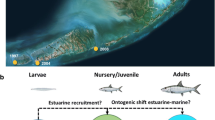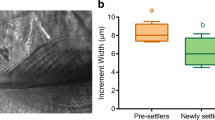Abstract
Otolith chemistry can be used to assess pelagic larval fish connectivity by comparing spatially variable otolith edge chemistry (corresponding to the site of collection) to otolith core chemistry (corresponding to the site of hatching). However, because the otolith’s edge and core represent different life stages, the deposition of elements may differ, thus complicating direct comparisons of edge and core chemistry to investigate connectivity. Here we present data from a field experiment in which otoliths from embryos (3 days post-fertilization) and juveniles of Stegastes partitus were collected at the same site and time, and chemically analyzed to assess whether elemental concentrations of otoliths vary ontogenetically. Separate multivariate analyses, each investigating the spatial/temporal variability in the chemistry of either embryo otoliths or the edges of juvenile otoliths, revealed significant differences, suggesting an environmental influence to the chemical signals of otoliths. A nested multivariate analysis assessing whether otolith chemistry varied with life history stage (i.e., ontogenetic variability) indicated that elemental concentrations of embryo otoliths were significantly greater than that of juvenile otolith edges. Specifically, embryo elemental concentrations of Mn, Zn, Sn, Ba, Ce, and Pb were between 2 and 163 times greater than those of the corresponding juvenile otoliths, and thus the environment was not the primary determinant of embryo otolith chemistry. Consequently, caution is warranted when interpreting environmental patterns of otolith cores, particularly when using them as a proxy for natal signatures.


Similar content being viewed by others
References
van Achterbergh E, Ryan C, Jackson S, Griffin W (2001) Data reduction software for LA-ICPMS. In: Sylvester P (ed) Laser-ablation-ICPMS in the earth sciences: principles and applications. Mineralogy Association of Canada, Ottawa, pp 239–343
Anderson MJ (2001) A new method for non-parametric multivariate analysis of variance. Aust Ecol 26: 32–46
Anderson MJ (2003) XMATRIX: a FORTRAN computer program for calculating design matrices for terms in ANOVA designs in a linear model Department of Statistics, University of Auckland, New Zealand
Anderson MJ (2004) DISTLM v.5: a FORTRAN computer program to calculate a distance-based multivariate analysis for a linear model Department of Statistics, University of Auckland, New Zealand
Bath GE, Thorrold SR, Jones CM, Campana SE, McLaren JW, Lam JWH (2000) Strontium and barium uptake in aragonitic otoliths of marine fish. Geochim Cosmochim Acta 64: 1705–1714
Bettiol AA, Yang C, Hawkes GP, Jamieson DN, Malmqvist KG, Day RW (1999) Identification of growth lines in abalone shell using a nuclear microprobe. Nucl Instrum Methods Phys Res Sect B Beam Interact Materials Atoms 158: 299–305
Brophy D, Jeffries TE, Danilowicz BS (2004) Elevated manganese concentrations at the cores of clupeid otoliths: possible environmental, physiological, or structural origins. Mar Biol 144:779–786
Brown R, Severin KP (1999) Elemental distribution within polymorphic inconnu (Stenodus leucichthys) otoliths is affected by crystal structure. Can J Fish Aquat Sci 56:1898–1903
Cole KS, Sadovy Y (1995) Evaluating the use of spawning success to estimate reproductive success in a Caribbean reef fish. J Fish Biol 47:181–191
Dulcic J (1998) Larval growth of sprat, Sprattus sprattus phalericus, larvae in the northern Adriatic. Fish Res 36: 117–126
Elsdon TS, Gillanders BM (2003) Relationship between water and otolith elemental concentrations in juvenile black bream Acanthopagrus butcheri. Mar Ecol Prog Ser 260:263–272
Elsdon TS, Gillanders BM (2005) Consistency of patterns between laboratory experiments and field collected fish in otolith chemistry: an example and applications for salinity reconstructions. Mar Freshw Res 56:609–617
Farrell J, Campana SE (1996) Regulation of calcium and strontium deposition on the otoliths of juvenile tilapia, Oreochromis niloticus. Comp Biochem Phys 115A:103–109
Fowler AJ, Campana SE, Jones CM, Thorrold SR (1995) Experimental assessment of the effect of temperature and salinity on elemental composition of otoliths using laser ablation ICPMS. Can J Fish Aquat Sci 52:1431–1441
Fox CJ, Folkvord A, Geffen AJ (2003) Otolith micro-increment formation in herring Clupea harengus larvae in relation to growth rate. Mar Ecol Prog Ser 264:83–94
Gallahar NK, Kingsford MJ (1996) Factors influencing Sr/Ca ratios in otoliths of Girella elevata: an experimental investigation. J Fish Biol 48:174–186
Gauldie RW (1996) Effects of temperature and vaterite replacement on the chemistry of metal ions in the otoliths of Oncorhynchus tshawytscha. Can J Fish Aquat Sci 53:2015–2026
Geffen AJ, Pearce NJG, Perkins WT (1998) Metal concentrations in fish otoliths in relation to body composition after laboratory exposure to mercury and lead. Mar Ecol Prog Ser 165:235–245
Gillanders BM (2002) Connectivity between juvenile and adult fish populations: do adults remain near their recruitment estuaries? Mar Ecol Prog Ser 240:215–223
Gillanders BM, Kingsford MJ (2003) Spatial variation in elemental composition of otoliths of three species of fish (Family Sparidae). Estuar Coast Shelf Sci 57:1049–1064
Hamer PA, Jenkins GP, Gillanders BM (2003) Otolith chemistry of juvenile snapper Pagrus auratus in Victorian waters: natural chemical tags and their temporal variation. Mar Eco Prog Ser 263:261–273
Jones CM, Chen Z (2003) New techniques for sampling larval and juvenile fish otoliths for trace-element analysis with laser-ablation sector-field inductively-coupled plasma mass spectrometry (SF-ICP-MS). In: Browman HI, Berit Skiftesvik A (eds) The big fish bang: Proceedings of the 26th annual larval fish conference, Institute of Marine Research, Norway, pp 431–443
Jones GP., Millcich MJ, Emsile MJ, Lunow C (1999) Self recruitment in a coral reef population. Nature 402:802–804
Kalish JM (1989) Otolith microchemistry: validation of the effects of physiology, age and environment on otolith composition. J Exp Mar Biol Ecol 132:151–178
Kalish JM (1991) Determinants of otolith chemistry: seasonal variation in the composition of blood plasma, endolymph and otoliths of bearded rock cod Pseudophycis barbatus. Mar Ecol Prog Ser 74:137–159
Kennedy BP, Klaue A, Blum JD, Folt CL, Nislow KH (2002) Reconstructing the lives of fish using Sr isotopes in otoliths. Can J Fish Aquat Sci 59:925–929
Knapp RA (1993) The influence of egg survivorship on the subsequent nest fidelity of female bicolor damselfish, Stegastes partitus. Anim Behav 46:111–121
McArdle BH, Anderson MJ (2001) Fitting multivariate models to community data: a comment on distance-based redundancy analysis. Ecology 82:290–297
Michibata H, Hori R (1979) The accumulation of manganese from the environmental medium by the egg of Oryzias latipes. J Cell Physiol 98:241–244
Millar RB (1987) Maximum likelihood estimation of mixed stock fishery composition. Can J Fish Aquat Sci 44:583–590
Millar RB (1990a) A versatile computer program for mixed stock fishery composition estimation. Can Tech Rep Fish Aquat Sci 1753:iii+29
Millar RB (1990b) Comparison of methods for estimating mixed stock fishery composition. Can J Fish Aquat Sci 47:2235–2241
Milton DA, Chenery SR (2001) Sources and uptake of trace metals in otoliths of juvenile barramundi (Lates calcarifer). J Exp Mar Biol Ecol 264:47–65
Morales-Nin B, Swan SC, Gordon JDM, Palmer M, Geffen AJ, Shimmield T, Sawyer T (2005) Age-related trends in otolith chemistry of Merluccius merluccius from the north-eastern Atlantic Ocean and the western Mediterranean Sea. Mar Freshw Res 56:599–607
Mora C, Sale PF (2002) Are populations of coral reef fish open or closed? Trends Ecol Evol 17:422–429
Nemeth RS (1998) The effect of natural variation in substrate architecture on the survival of juvenile bicolor damselfish. Environ Biol Fish 53:129–141
Otake T, Ishii T, Nakahara M, Nakamura R (1994) Drastic changes in otolith strontium/calcium ratios in leptocephali and glass eels of Japanese eel Anguilla japonica. Mar Eco Prog Ser 112:189–193
Pisam M, Jammet C, Laurent D (2002) First steps of otolith formation of the zebrafish: role of glycogen? Cell Tissue Res 310:163–168
de Pontual H, Geffen AJ (2002) Otolith microchemistry In: Panfili J, de Pontual H, Troadec H, Wright PJ (eds) Manual of fish sclerochronology. Ifremer, Plouzane, France, pp. 243–303
de Pontual H, Lagardere F, Amara R, Bohn M, Ogor A (2003) Influence of ontogenetic and environmental changes in the otolith microchemistry of juvenile sole (Solea Solea). J Sea Res 50:199–210
Robertson DR, Green DG, Victor BC (1988) Temporal coupling of production and recruitment of larvae of a Caribbean reef fish. Ecology 69:370–381
Russ GR (2002) Yet another review of marine reserves as reef fishery management tools. In: Sale PF (ed) Coral reef fishes: dynamics and diversity in a complex ecosystem. Academic, New York, pp 421–443
Ruttenberg BI, Hamilton SL, Hickford MJH, Paradis GL, Sheehy MS, Standish JD, Ben-Tzvi O, Warner RR (2005) Elevated levels of trace elements in cores of otoliths and their potential for use as natural tags. Mar Ecol Prog Ser 297:273–281
Sale PF, Cowen RK, Danilowicz BS, Jones GP, Kritzer JP, Lindeman KC, Planes S, Polunin NVC, Russ GR, Sadovy YJ, Steneck RS (2005) Critical science gaps impede use of no-take fishery reserves. Trends Ecol Evol 20:74–80
StatSoft, Inc (2001) STATISTICA (data analysis software system), version 6. www.statsoft.com. Tulsa, OK
Strong MB, Neilson JD, Hunt JJ (1986) Aberrant crystallization of pollock (Pollachius virens ) otoliths. Can J Fish Aquat Sci 43:1457–1463
Swearer SE, Caselle JE, Lea DW, Warner RR (1999) Larval retention and recruitment in an island population of a coral-reef fish. Nature 402:799–802
Taylor MS, Hellberg ME (2003) Genetic evidence for local retention of pelagic larvae in a Caribbean reef fish. Science 299:107–109
Thorrold SR, Jones CM, Swart PK, Targett TE (1998) Accurate classification of juvenile weakfish Cynoscion regalis to estuarine nursery areas based on chemical signatures in otoliths. Mar Ecol Prog Ser 173:253–265
Thorrold SR, Latkoczy C, Swart PK, Jones CM (2001) Natal homing in a marine fish metapopulation. Science 291:297–299
Tomas J, Geffen AJ (2003) Morphometry and composition of aragonite and vaterite otoliths of deformed laboratory reared juvenile herring from two populations. J Fish Biol 63:1383–1401
Toole CL, Markle DF, Harris PM (1993) Relationships between otolith microstructure, microchemistry, and early life history events in Dover sole, Microstomus pacificus. Fish Bull 91:732–753
Valles H, Sponaugle S, Oxenford HA (2001) Larval supply to a marine reserve and adjacent fished area in the Soufriere Marine Management Area, St Lucia, West Indies. J Fish Biol 59:157–177
Volk EC, Blakley A, Schroder SL, Kuehner SM (2000) Otolith chemistry reflects migratory characteristics of Pacific salmonids: using otolith core chemistry to distinguish maternal associations with sea and freshwaters. Fish Res 46:251–266
Wellington GM, Victor BC (1989) Planktonic larval duration of one hundred species of Pacific and Atlantic damselfishes (Pomacentridae). Mar Biol 101:557–567
Wilson DT, Meekan MG (2002) Growth-related advantages for survival to the point of replenishment in the coral reef fish Stegastes partitus (Pomacentridae). Mar Ecol Prog Ser 231:247–260
Acknowledgements
We thank B. Wells, L. Corkum, J. Lovett-Doust, J. Kritzer, M. Crawford, B. Zielinski, N. Tolimieri, and an anonymous reviewer for their constructive comments and J.C. Barrette and E. Arias for logistical support. This study was supported by an NSERC CRO (grant no. 227965) awarded to P. Sale and an Ontario Graduate Scholarship awarded to P. Chittaro.
Author information
Authors and Affiliations
Corresponding author
Additional information
Communicated by R.J. Thompson, St. John´s
Rights and permissions
About this article
Cite this article
Chittaro, P.M., Hogan, J.D., Gagnon, J. et al. In situ experiment of ontogenetic variability in the otolith chemistry of Stegastes partitus . Mar Biol 149, 1227–1235 (2006). https://doi.org/10.1007/s00227-006-0280-x
Received:
Accepted:
Published:
Issue Date:
DOI: https://doi.org/10.1007/s00227-006-0280-x




